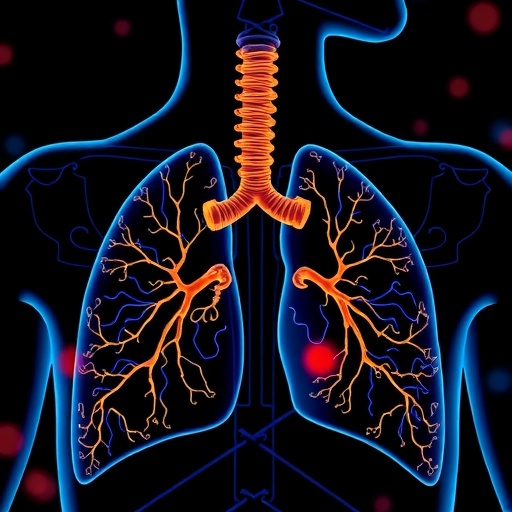In an era where chronic respiratory diseases pose significant health challenges, recent research highlights a potentially groundbreaking treatment for bronchiectasis involving the natural compound apigenin. A new study published in Scientific Reports unveils exciting insights into the molecular mechanisms by which apigenin could alleviate this debilitating condition, characterized by the abnormal dilation of the bronchi and chronic pulmonary inflammation. This development opens new avenues not just in pharmaceutical research but also in holistic approaches to respiratory health.
Bronchiectasis is often a result of recurring inflammation or infection of the airways, leading to persistent cough, sputum production, and, in severe cases, respiratory failure. The traditional management of bronchiectasis includes underlying infection treatment, mucosal secretion clearance therapies, and support for airway inflammation. However, as the limits of these conventional treatments become apparent, there is an urgent need for novel therapeutics that may address the root biological mechanisms of the disease. This sets the stage for the promising role of apigenin as a potential therapeutic agent.
Apigenin, a flavonoid widely found in various fruits and vegetables—most notably in parsley, chamomile, and celery—has garnered attention for its diverse biological activities. The study conducted by Huang et al. employs network pharmacology and molecular docking strategies to unravel how apigenin interacts with various biological targets related to bronchiectasis. By utilizing these advanced techniques, researchers can elucidate the complex interplay between apigenin and disease-related pathways, thereby enhancing our understanding of its therapeutic potential.
Network pharmacology allows researchers to explore the holistic effects of compounds like apigenin by examining their interactions on a systemic level. In the context of bronchiectasis, this approach presents a compelling case for the multifunctional capabilities of apigenin. The findings indicate that apigenin may exert anti-inflammatory properties, modulate immune responses, and even provide antioxidative protection within the bronchi.
Moreover, molecular docking simulations in this study revealed that apigenin could effectively bind to specific proteins involved in the inflammatory process. This crucial interaction suggests that apigenin might modulate the biological activity of these proteins, paving the way for lessening the chronic inflammation seen in bronchiectasis. This molecular insight is critical as it not only validates apigenin’s potential but also provides a scaffold for further exploration in drug development.
In addition to its promising pharmacological profiles, the stability and bioavailability of apigenin are key factors that can influence its therapeutic efficacy. Future research should prioritize the development of suitable formulations that enhance the absorption and effectiveness of apigenin within the respiratory system. These advancements could lead to not just improved clinical outcomes but also a more significant paradigm shift in how bronchiectasis is treated.
The integration of apigenin in combination therapies also presents an intriguing area for further research. Many chronic conditions, including bronchiectasis, often require multifaceted therapeutic strategies to achieve optimal management. Investigating the synergistic effects of apigenin with other natural compounds could unlock new therapeutic regimens, offering patients a holistic treatment paradigm that emphasizes both efficacy and safety.
However, translating these laboratory findings into clinically viable treatments will require robust in vivo studies to confirm the therapeutic mechanisms of apigenin. This step is crucial not only for validating its efficacy but also for assessing any potential side effects resulting from long-term usage. Clinical trials will play a pivotal role in this development phase, enabling researchers to collect substantial real-world data on how apigenin can be utilized effectively in bronchiectasis management.
Securing patent protection is another essential milestone in drug development that researchers must navigate when introducing apigenin-based therapies into the market. Intellectual property rights can encourage further research investment while simultaneously ensuring that the innovators receive due credit and financial backing for their work. This aspect is vital for the sustainable development of new treatments that challenge conventional approaches.
As the scientific community continues to delve deeper into the study of apigenin, the anticipation surrounding its potential application for bronchiectasis grows. The compound’s origins as a plant-derived substance resonate with a growing trend toward natural therapies and integrative medicine, reflecting the shift in patient preferences towards less invasive and more holistic forms of treatment.
Ultimately, the research led by Huang et al. represents a promising intersection of plant biology, pharmacology, and respiratory medicine. With a wealth of future studies ahead, the full therapeutic capabilities of apigenin may soon be brought to light, offering renewed hope for patients suffering from bronchiectasis. Its development might also contribute to a broader understanding of how natural compounds can be harnessed in the fight against chronic diseases.
As this research moves forward, the future looks bright for understanding and utilizing apigenin as a therapeutic agent. With collaborative efforts across various scientific disciplines, there’s potential for apigenin to evolve into not just a treatment for bronchiectasis, but a reference point for novel strategies in addressing chronic inflammatory diseases at large. The call for further exploration into its synergistic effects, formulation advancements, and streamlined pathways for clinical trials indicates a robust trajectory for this promising compound.
In sum, the journey to establish apigenin as a cornerstone treatment for bronchiectasis encapsulates the evolving landscape of modern medicine. By leveraging innovative research methodologies, such as network pharmacology and molecular docking, researchers are setting the groundwork for a paradigm shift that aligns with the future goals of therapeutic efficacy and patient-centric care. As these studies progress, the medical community and patients alike can anticipate the unveiling of new treatment modalities that may significantly improve quality of life for those affected by bronchiectasis.
Subject of Research: Apigenin as a therapeutic agent for bronchiectasis
Article Title: Exploring the molecular mechanism of apigenin in treating bronchiectasis based on network pharmacology and molecular docking.
Article References: Huang, H., Han, J., Liu, Y. et al. Exploring the molecular mechanism of apigenin in treating bronchiectasis based on network pharmacology and molecular docking. Sci Rep 15, 39161 (2025). https://doi.org/10.1038/s41598-025-24377-x
Image Credits: AI Generated
DOI: https://doi.org/10.1038/s41598-025-24377-x
Keywords: Apigenin, Bronchiectasis, Natural compounds, Therapeutic strategies, Molecular docking, Network pharmacology, Chronic respiratory diseases.




